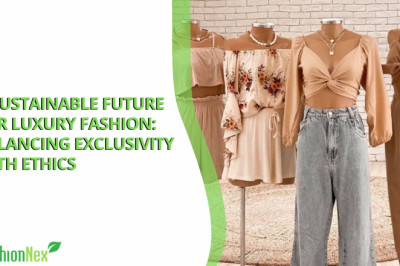views

The convergence of fashion, technology, and sustainability has grown in importance recently, and the fashion industry has always been at the forefront of innovation. There is an urgent need for sustainable solutions that lessen waste, conserve resources, and support ethical practices in light of the growing awareness of the effects of the fashion industry on society and the environment.
The development of sustainable materials, increased supply chain transparency, and the availability of circular business models have all been made possible by technological breakthroughs. The fashion industry is embracing sustainable solutions to suit the rising demand for ethical and ecologically conscious apparel, from using recycled textiles to implementing 3D printing technology.
The industry's future, as well as the health of the world and its inhabitants, depends on the combination of technology and sustainability.
Collaborations Between Fashion And Technology
Collaborations between fashion and technology companies have become increasingly popular in recent years. These partnerships have created innovative products that merge style and function, resulting in exciting new opportunities for both industries. Some examples of collaborations between fashion and technology companies include:
The future of sustainable fashion trends and predictions is also closely tied to these collaborations, with many companies seeking to incorporate eco-friendly materials and production methods into their designs.
Google and Levi's: Google and Levi's collaborated to create "Project Jacquard," a fabric that can be woven with conductive threads, allowing wearers to control their electronic devices with gestures.
Nike and Apple: Nike and Apple teamed up to create the Nike+iPod Sport Kit, which allows runners to track their progress using an iPod.
Fossil and Intel: Fossil and Intel partnered to create a line of smartwatches that combine fashion with technology, allowing users to stay connected while still looking stylish.
Increased innovation, access to new markets, and improved consumer experiences are just a few advantages of these partnerships. The requirements and preferences of contemporary consumers can be met by fashion and technology companies collaborating to create goods that combine both functionality and style.
The use of technology to produce more environmentally friendly materials and increase supply chain transparency can also result in more ethical and sustainable practices in the fashion industry. In the end, the advantages of these partnerships are numerous and diverse, opening up fascinating new opportunities in the fields of fashion and technology.
Related- Vegan Fashion: The Latest Trend in Sustainability
Sustainable Solutions In Fashion
The fashion industry has a significant impact on the environment, with many of its practices contributing to issues such as pollution, resource depletion, and waste. From the production of textiles to the disposal of clothing, each stage of the fashion lifecycle has a significant environmental footprint.
For example, the production of conventional cotton involves the use of pesticides and water-intensive farming practices, while the fast fashion model leads to excessive consumption and disposal of clothing.
To alleviate these environmental effects, sustainable solutions are essential. The fashion business can do its part to protect the environment by cutting waste, saving resources, and promoting moral behavior.
Utilizing environmentally friendly materials like organic cotton, implementing circular business models that encourage recycling and upcycling, and enhancing supply chain transparency to ensure moral labor practices are all examples of sustainable solutions. The fashion industry can lessen its harmful effects on the environment and help create a more sustainable future by adopting sustainable solutions.
Examples Of Collaborations For Sustainable Solutions
Collaborations between fashion and technology companies have also led to sustainable solutions in the industry. Some examples of these collaborations include:
- Adidas and Parley for the Oceans: Adidas and Parley for the Oceans collaborated to create a range of sneakers made from recycled ocean plastic. This collaboration promotes the use of sustainable materials and aims to reduce plastic waste in the ocean.
- Burberry and Elvis & Kresse: Burberry collaborated with Elvis & Kresse to create a line of accessories made from discarded Burberry leather scraps. This collaboration promotes circular economy principles by repurposing waste into new products.
- H&M and Treetotextile: H&M partnered with Treetotextile to create a sustainable alternative to cotton by using fibers derived from sustainably managed forests. This collaboration promotes the development of sustainable materials through technology.
- Stella McCartney and Bolt Threads: Stella McCartney collaborated with Bolt Threads to create a vegan silk made from yeast. This collaboration promotes sustainable solutions through the use of innovative technology.
Companies in the fashion and technology sectors can lessen the industry's environmental effects while advancing moral behavior by working together on sustainable solutions. These partnerships may result in the creation of novel materials, increased supply chain transparency, and technological application of the circular economy's guiding principles. A more sustainable and accountable fashion business may eventually result from this sustainable cooperation.
Challenges And Limitations
The following are some difficulties facing fashion and technology collaborations:
- Different priorities: Fashion and technology companies frequently have different objectives, which can make working together difficult.
- Innovation speed: Fashion companies may find it challenging to keep up with the rapid advancement of technology.
- Cost: Creating new technology and incorporating it into apparel can be pricey.
The following are some existing technology limitations for eco-friendly fashion solutions:
- Limited availability of sustainable materials: Although there are sustainable materials available, the fashion industry has not yet adopted them extensively.
- Lack of scalability: Some environmentally friendly options, like 3D printing or using recycled materials, are still not very scalable.
- Energy use: Producing sustainable materials frequently necessitates large amounts of energy, which might counteract some of the environmental advantages.
Related- Fashion as a Tool for Social Change: Empowering Women and Supporting Communities
Fashionnex Final Words
In conclusion, collaborations between fashion and technology companies have become increasingly important in the pursuit of sustainable solutions in the fashion industry. These partnerships have resulted in innovative products that combine style and function while promoting ethical and environmentally responsible practices.
With technology advancing at an unprecedented pace, there is immense potential for these collaborations to continue shaping the future of fashion. By leveraging each other's strengths, fashion and technology companies can create products that meet the needs and preferences of modern consumers, while also promoting sustainability and transparency.
As consumers become increasingly conscious of the impact of their choices on the environment and society, these collaborations are likely to play a crucial role in the fashion industry's future, paving the way for a more sustainable and equitable future.











Comments
0 comment